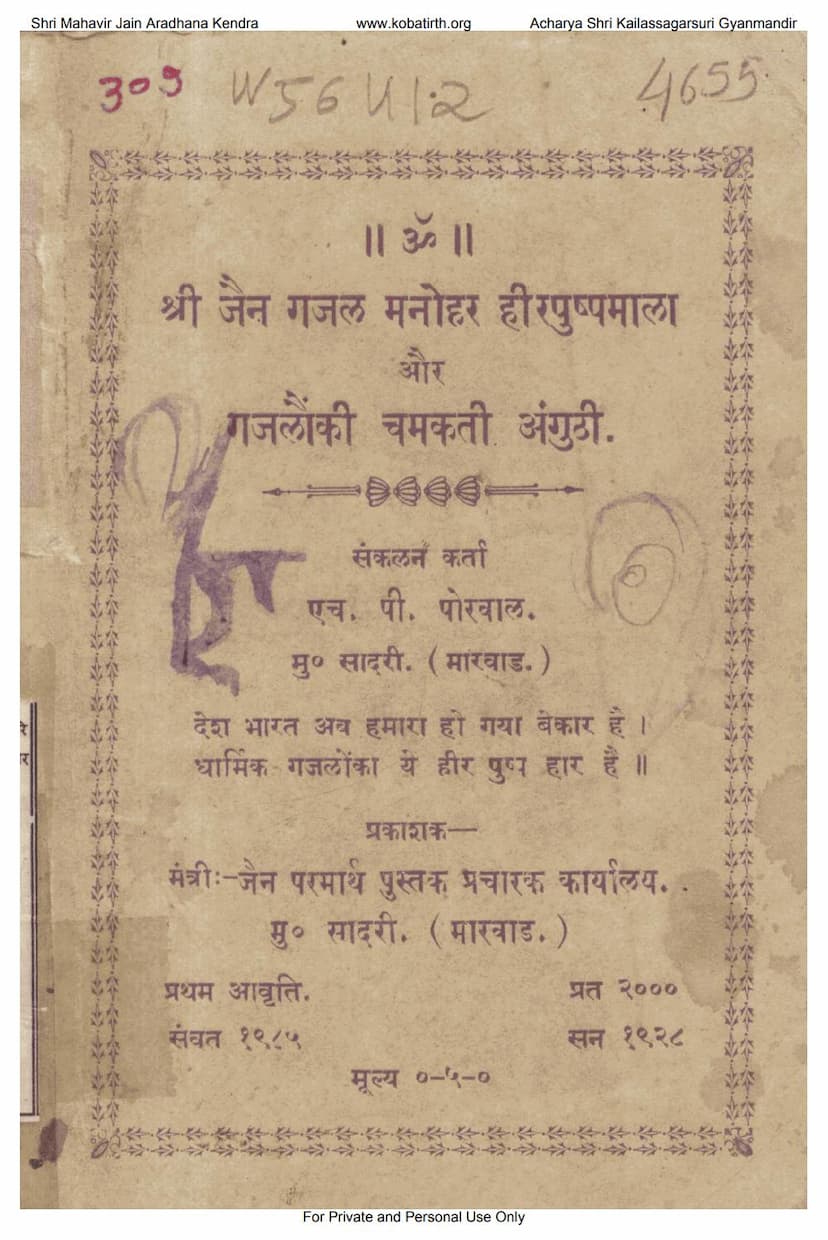Jain Gajal Manohar Hir Pushpmala
Added to library: September 2, 2025

Summary
Here's a comprehensive summary of the Jain text "Jain Gajal Manohar Hir Pushpmala" by H. P. Porwal, published by Jain Parmarth Pustak Pracharak Karyalay:
Book Title: Jain Gajal Manohar Hir Pushpmala (Also referred to as "Jain Gajaloki Chamakti Anguthi" - The Sparkling Ring of Jain Ghazals) Author: H. P. Porwal Publisher: Jain Parmarth Pustak Pracharak Karyalay Catalog Link: https://jainqq.org/explore/020387/1
Overview:
"Jain Gajal Manohar Hir Pushpmala" is a collection of devotional poems, primarily in the form of ghazals and other lyrical compositions, dedicated to the teachings and deities of Jainism. The book aims to inspire spiritual devotion, detachment from worldly pleasures, and a path towards liberation (moksha) through the remembrance and worship of the Tirthankaras, particularly Adinath (Rishabhdev), Parshvanath, and Mahavir Swami. The language used is Hindi, with occasional Gujarati influences. The collection is presented as a "garland of jewel-like flowers" and a "sparkling ring," symbolizing the preciousness and brilliance of the spiritual message.
Key Themes and Content:
The poems in this collection are deeply rooted in Jain philosophy and practice. They primarily focus on:
- Devotion to Tirthankaras: The verses express profound reverence and adoration for the Jinas (victorious ones), highlighting their virtues, their role as guides to liberation, and the benefits of remembering their names and meditating on their forms. Specific Tirthankaras mentioned include Rishabhdev (Adinath), Parshvanath, Kuntunath, and Mahavir Swami.
- Renunciation and Detachment (Vairagya): A central theme is the impermanence of worldly life, possessions, and relationships. The ghazals repeatedly urge the reader to detach from these transient elements, recognizing their illusory nature and the suffering they bring. The futility of worldly pursuits and the ego is emphasized.
- The Cycle of Birth and Death (Samsara): The poems lament the soul's long journey through various life forms (8.4 million species) and the suffering inherent in the cycle of rebirth and death. The desire to break free from this cycle and attain moksha is a constant plea.
- Path to Liberation (Moksha): The verses clearly indicate that the path to liberation lies in the devotion to the Jinas, adherence to Jain principles, meditation, and the eradication of karmas. The poems serve as spiritual guidance, encouraging the reader to turn towards the Jain path for true happiness and ultimate freedom.
- Spiritual Awakening and Self-Realization: The collection calls for spiritual awakening, urging individuals to shed ignorance, delusion, and negative emotions (like anger, pride, deceit, and greed). The pursuit of self-knowledge and the realization of the soul's true nature are encouraged.
- Critique of Worldly Attachments and Hypocrisy: Some ghazals express a critical view of superficial adherence to Jainism, highlighting those who claim to be Jain but engage in unrighteous activities or worldly attachments, neglecting the core principles of the faith.
Structural and Stylistic Features:
- Ghazal Form: The collection primarily utilizes the ghazal form, characterized by its rhyming couplets (sher), consistent rhyme scheme (qafiya and radif), and a concluding couplet (maqta) where the poet might address themselves or their pen name.
- Lyrical and Melodious: The poems are written with a strong emphasis on rhythm and melody, making them suitable for devotional singing or recitation. Various tunes (tarz) are suggested for different poems.
- Emotional Expression: The ghazals convey a range of emotions, from deep sorrow and repentance for past actions to fervent hope and devotion towards the Tirthankaras.
- Use of Metaphors and Imagery: The text employs rich metaphors and imagery, such as the "ocean of existence," "jewel-like flowers," "sparkling ring," "lotus-like face," and "serpent of attachment," to illustrate spiritual concepts.
Publisher's Note and Appeal:
The publication information indicates that the book was first published in Samvat 1985 (1928 AD) with an edition of 2000 copies. The publisher, Shri Jain Parmarth Pustak Pracharak Karyalay, based in Sadri (Marwar), is dedicated to spreading Jain literature. A note from the author/compiler, H. P. Porwal, requests readers to return the book promptly after use so others can benefit. The later pages also contain an appeal for donations to support the publication and distribution of Jain literature, emphasizing the importance of spreading pure, beautiful, and affordable books, especially in regions where Jain scriptures might be less accessible. It highlights the success of their efforts in distributing numerous books to various places.
In essence, "Jain Gajal Manohar Hir Pushpmala" is a spiritual compilation designed to draw readers closer to Jain principles and the Tirthankaras. It serves as a devotional guide, encouraging a life of detachment, virtue, and ultimately, the attainment of spiritual liberation.